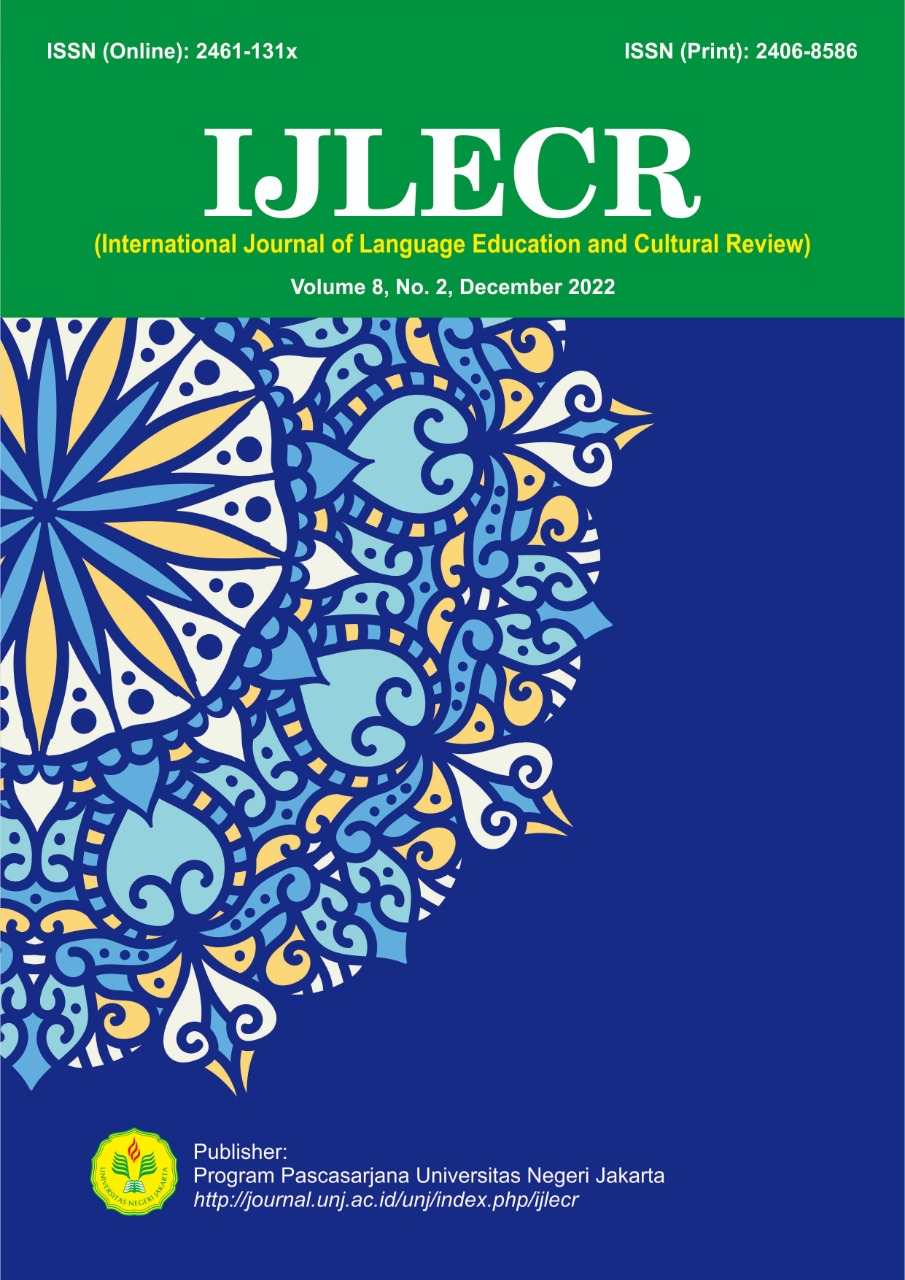Deep Structure in the Nobel Qur’an
DOI:
https://doi.org/10.21009/ijlecr.v8i2.12849Keywords:
translation, deep structure, meaning components, the Noble Qur’anAbstract
The objective of this research was to analyze the deep structure in the translation of Noble Qur’an. Since translation goal is meaning (deep structure), this study is badly needed. The theory of deep structure is proposed by Avram Noam Chomsky. This research is a content analysis method and reading, classifying, note-taking techniques for collecting data. The source data is taken from the Noble Qur’an, English translation and commentary translated by Dr Muhammad Taqi-ud-Din Al-Hilali dan Dr Muhammad Muhsin Khan. The research discusses some meaning components in the translation of Nobel Qur’an, there are eight meaning component strategies, i.e. (1) Features of form was found in 15 translated texts or 13%, (2) Function was found in 2 translated texts or 2%, (3) Form and function was found in 29 translated texts or 26%, (4) Comparison was found in 6 translated texts or 5%, (5) Classifier was found in 8 translated texts or 7%, (6) Couplets, triplets, quadruplets and quintaplets were found in 31 translated texts or 13%, (7) Synonym was found in 11 translated texts or 10%, and (8) Synonim plus reference was found in 5 translated texts or 4%, (9) Synonym with no modification was found in 6 translated texts or 5%.
References
Chomsky, N. (2002). Syntatic stucture. New York: Mouton de Gruyter.
Febiani, A. (2014). The techniques used by J.M. Rodwell in translating some defensive verses of the Quran from Arabic into English. Vivid Journal, 3(1), 14. http://jurnalvivid.fib.unand.ac.id/index.php/vivid/article/view/13
Ismawati, S. (2013). The translation procedures in translating the cultural words in the young adult novel. Passage, 1(2), 55–62. https://ejournal.upi.edu/index.php/psg/article/view/537
Japhari, S. (2019). Translation of the book titled ‘Authentication of hadith: Redefining the criteria’ from English into Swahili: An analysis of translation procedures. SSRN Electronic Journal, (1999), 130–136. https://doi.org/10.2139/ssrn.3441606
Larson, M. L. (1998). Meaning based translation: A guide to cross-language equivalence. Lanham: University Press of America.
Mashhady, H., Pourgalavi, M., & Fatollahi, M. (2015). Newmark’s procedures in Persian translation of golding’s. International Journal of English Language & Translation Studies. 3(1), 57-69. Retrieved from Http://Www.Eltsjournal.Org, 3, 57–69.
Molina, L., & Albir, A. H. (2002). Translation techniques revisited: A dynamic and functionalist approach. Meta, 47(4), 498–512. https://doi.org/10.7202/008033ar
Newmark, P. (1988). A textbook of translation. U. K.: Prentice Hall International Ltd
Ordudari, M. (2013). Translation procedures, strategies and methods. Theory and Practice in Language Studies. https://doi.org/10.4304/tpls.3.5.781-789
Rajeg, G. P. W. (2020). Linguistik korpus kuantitatif dan kajian semantik leksikal sinonim emosi bahasa Indonesia. Linguistik Indonesia, 38(2), 123–150. https://doi.org/10.26499/li.v38i2.155
Sharififar, M. (2010). Applicability of Newmark ’ s procedures to translation of religious cultural elements from English into Persian. Iranian Journal of Applied Language Studies, 2(1), 169–190.
Sipayung, R. W. (2017). Couplet translation procedure on Makhioui wedding. Journal, International Language, English Vol, Teaching Centre, European Uk, Development, 5(6), 70–80.
Widiarto, O. V. V. (2016). The translation procedures of cultural expressions applied in “A game of Thrones .” LITE Journal, 12(2), 20.
Wu, Y., & Xu, R. (2011). The application of Chomsky’s syntactic theory in translation study. Journal of Language Teaching and Research, 2(2), 396–399. https://doi.org/10.4304/jltr.2.2.396-399








